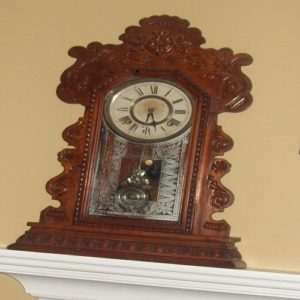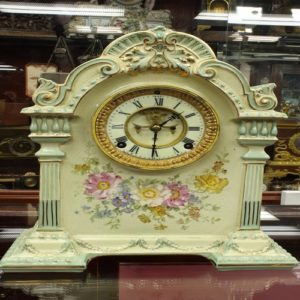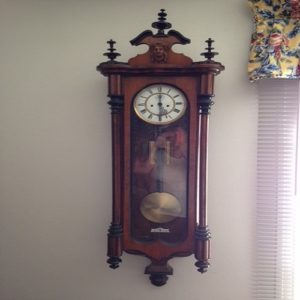Table of Contents
Identifying antique clocks from the 1800s can be a challenge. There are several factors to consider. Whether you are looking for a timepiece for your home or for a historical museum, you will need to do some research to ensure that you are buying a quality item.
Antique clocks from the 1800s
Whether you’re looking for a wall mounted clock or a mantel piece, there are many types of antique clocks to choose from. They can be found in many different places, from flea markets to antique stores.
When searching for antique clocks, it’s important to identify the manufacturer. Usually, this will be engraved on the face or on the back of the clock. Occasionally, a manufacturer’s name or logo will be affixed on the case.

Various types of striking bells are also common on antique clocks. These bells range from simple ones to ones with a clucky sound. A flying pendulum is also a feature on some antique clocks. It is usually attached to the clock, but can be detached as well.
One of the most popular designs made by New Haven during the 1800s was the mantle clock. This clock has a glass plate at the bottom, often decorated with paintings.
Another popular style of clock was the calendar clock. These clocks were made with double dials for the time and date. Some of the clocks had the words “Fashion” and “Family” engraved between the two double dials.
Another American clockmaker was Aaron Willard Jr. He made a number of clocks, including tall clocks. He was born in Canton, Massachusetts. His tall clocks were made of mahogany.
What old clocks are worth money?
Whether you are buying or selling antique clocks, you must know how to value them properly. You must also know the difference between rare antique clocks and the mass-produced ones.
One of the most important things to consider when evaluating a clock is its age. However, this does not always equate to a higher value.
Another factor to consider is the condition of the clock. If the clock has been repaired or is missing components, it will lower its value. Likewise, a badly repainted dial can hurt its value.

The materials used for antique clock components can also impact its value. The value of porcelain clocks is higher. However, the value of Chinese clocks and Korean clocks is not high.
It is also important to consider the design of the clock. The design of many clocks changed drastically in the 1960s and 1970s. It is best to check the maker’s label to find out more about the clock’s age.
Another factor to consider is the origin of the clock. Buying a clock from a reputable maker will increase its value. However, buying a clock from a manufacturer that is unknown will not increase its value.
Besides the origin of the clock, it is also important to consider the manufacturer’s signature. This makes it easier to estimate the age of the clock.
How do I identify my antique clock?
Identifying an antique clock can be a daunting task. There are several factors to take into account, including the mechanism, the clock type, and the age of the clock.
One of the easiest ways to identify an antique clock is by its type. This helps to determine the value of the clock. The most valuable antique clocks are ones that have mechanically impressive mechanisms. Another factor that can help is the type of glass. The type of glass used can help you determine when the clock was made.
The second most important factor in identifying an antique clock is the manufacturer. Clocks were made by many different companies, often in different locations. If you know the history of the company that made the clock, you can tell when it was made.

A clock maker’s signature on the dial can help you determine when it was made. Some clock makers sign the movement, as well. A clock with a maker’s signature is more valuable than one without.
The name of the retailer may also help you identify the clock. Many companies changed their names over the years. If the clock was purchased by a bulk buyer, you may find that they engraved their name on the dial.
How common were clocks in the 1800s?
During the 1800s, there was a growing demand for clocks. They were valued for their looks and practicality. They were also produced by different manufacturers. The best way to identify a clock is the movement.
Early American clocks used wooden movements. These were replaced by brass movements in the early 1840s. However, identifying the model name is difficult. The name can be found on the label on the case or in the manufacturer’s catalog.
Early white dials were very sparsely decorated. They consisted of gold paint spandrels in the corners. These spandrels were cast to resemble the spandrels on a brass dial. The hands were made of steel and were not as well-matched as the ones on a brass dial.
Brass dials were also produced in Southern counties. They continued to be produced in the Southern counties until 1830. In the 1820s, brass became cheaper to work with. However, the use of brass dials diminished.
The earliest clocks were eleven inches wide and had small dials. These dials used Roman numerals for the hours and dots for the minutes. They were not as accurate as the dials on later clocks.
Clockmakers also developed techniques for decorating their clocks. They were inspired by classical sculptures and paintings. The faces became more complex and detailed.
How old does a clock have to be to be an antique?
Choosing an antique clock can be a bit daunting. There are a lot of different factors to consider. It can be difficult to determine which clock is the most valuable.
Clocks come in many different materials, shapes, and sizes. In fact, there are thousands of different clocks made by many different companies.
There are a few key factors to consider when determining the value of a clock. One of the best ways to determine the age of a clock is by examining its construction.
This is because the construction of a clock can reveal a lot about the date it was made. It also helps to identify the model and type of clock.
Another key factor is the movement. This is the best chance to determine the age of a clock. If a clock has a movement that was not originally made, it’s not worth much. If the movement is original, the clock is worth more than a modern clock.
The best way to determine the age of a clock is to have it appraised by a professional. You may also want to discuss the history of the clock with the owner.
If you have an antique clock, it’s a good idea to have it serviced. This is especially true if it’s more than a few years old. A full clock service should be performed after 10 years.
Is there an app to identify antique items?
Identifying antique clocks from the 1800s can be a challenge. There are a lot of variables to consider, and you need to know what to look for.
A good place to start is with the manufacturer. Look for a label on the clock or the manufacturer’s catalog. The model name is sometimes printed on a sticker on the case.
Another important part of the identification process is to look at the movement. Identifying the model and movement are the two best ways to determine a clock’s age.
A clock’s pendulum may have been replaced with a new one. The clock’s case may have been altered to hide these changes. The movement may have been replaced with a different brand.
The best guarantee for a clock’s authenticity is to ensure that the same mark appears on the movement and dial. A clock’s maker’s signature is also a good sign.
Other important pieces of information to look for include the model name, the manufacturer’s name, and the manufacturer’s logo. Some manufacturers didn’t bother with the model name. However, it’s more important to know the model name than it is to know the manufacturer’s name.
The Internet is a great source of information. There are plenty of websites dedicated to clocks. Many are in English, which is a great place to start. You may also want to check out specialized websites.
Conclusion
Whether you are looking for antique clocks from the 1800s or a more modern clock, you need to know how to identify the clock. You will find that there are many resources available to help you with your task. There are a number of books and information sites that deal with antique clock identification.
In order to properly identify an antique clock, you need to know about the time, the movement, and the maker’s signature. It is also important to know the company’s name and serial number. If the movement is not original, most collectors will consider the clock worthless.
The most effective way to identify an antique clock is to look at the movement. The movement is the most complicated part of the clock and it is the only area where you can truly determine its age. You may be surprised to find that there are many different types of movement. Some are made of brass, others are made of wood, and others are made of plastic.
Another great resource for identifying antique clocks is the British hallmarks. These are available in many places. You can also find out the maker’s name from the back of the clock case. The best part about this is that you can see the maker’s signature.